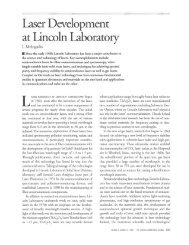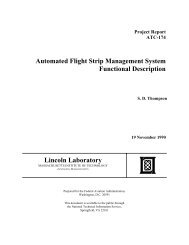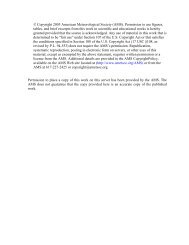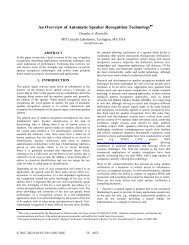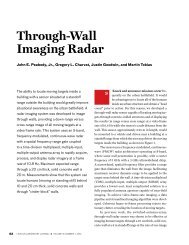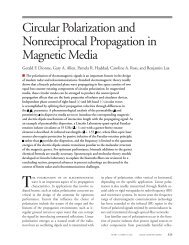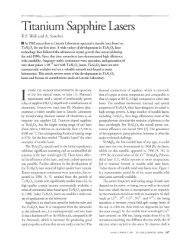The Route Availability Planning Tool (RAPT) - MIT Lincoln Laboratory
The Route Availability Planning Tool (RAPT) - MIT Lincoln Laboratory
The Route Availability Planning Tool (RAPT) - MIT Lincoln Laboratory
Create successful ePaper yourself
Turn your PDF publications into a flip-book with our unique Google optimized e-Paper software.
during YELLOW periods), real time <strong>RAPT</strong> forecast scores<br />
and more clarity in the operational display.<br />
Figure 11 illustrates these enhancements on the planned<br />
2009 user interface, developed in discussions during a user<br />
focus group meeting in December, 2008. Weather impact<br />
trends for each departure route are identified as ‘improving’<br />
(upward arrow), ‘deteriorating’ (downward arrow) or ‘stable’<br />
(right-pointing arrow). Trends are based on the history of<br />
impacts over the previous half-hour. A ‘PIG timer’ gives the<br />
time, in minutes, since the weather impacts have cleared the<br />
route. Users can ‘drill down’ to see detailed trend information<br />
by clicking on the trend arrow. <strong>The</strong> trend information includes<br />
the previous 30 minute history of <strong>RAPT</strong> status and echo top<br />
EWR ELIOT J64 drilldown<br />
50<br />
Past 30 minute <strong>RAPT</strong> status trend<br />
40<br />
(height reflects echo top)<br />
30<br />
ConOps: Release Under Guidance<br />
CLOSE<br />
heights encountered along the departure route, and a text<br />
message that reminds the user of the action that is suggested<br />
by the <strong>RAPT</strong> concept of operations under the current<br />
conditions. An improved route timeline display filter enables<br />
users to display only the departure routes that are of interest.<br />
<strong>RAPT</strong> forecast scores, based on the route blockage scoring<br />
algorithm presented in [10], are calculated for each of the<br />
regions that include the major departure routes in the <strong>RAPT</strong><br />
domain. <strong>The</strong> blockage score takes into account the spatial scale<br />
and orientation of the routes and their geometric relationship to<br />
the weather. Both the trend and forecast algorithms are subjects<br />
of ongoing research and development.<br />
<strong>Route</strong> trend PIG 0610 0615 0620 0625 0630 0635 0640<br />
20<br />
Click on cell to see<br />
trend ‘drilldown’<br />
Timeline display filter allows user to focus only on specific routes of interest<br />
Figure 11. Proposed <strong>RAPT</strong> user interface for 2009.<br />
V. CONCLUSIONS<br />
<strong>The</strong> <strong>Route</strong> <strong>Availability</strong> <strong>Planning</strong> <strong>Tool</strong> (<strong>RAPT</strong>) is a<br />
prototype automated decision support tool that has been<br />
deployed in the New York area to help air traffic managers<br />
make departure decisions in convective weather SWAP. It<br />
predicts the impacts of convective weather on departure<br />
routes, providing a departure status (RED is blocked, GREEN<br />
is clear, DARK GREEN is insignificant impact and YELLOW<br />
is partially blocked or uncertain) for future departure times (up<br />
to 30 minutes) on specific departure routes. <strong>The</strong> <strong>RAPT</strong><br />
concept of operations is to enable proactive departure<br />
management decision making based on <strong>RAPT</strong> departure status<br />
predictions: plan reroutes for departure routes that are turning<br />
RED, reopen closed departure routes that are turning GREEN<br />
<strong>RAPT</strong> fc score<br />
North: 80%<br />
West: 60%<br />
South: 20%<br />
<strong>RAPT</strong> forecast<br />
score by<br />
departure group<br />
after weather impacts, and use trend information to support<br />
advanced planning when route impacts are YELLOW.<br />
<strong>The</strong> effectiveness of <strong>RAPT</strong> depends on the quality of its<br />
departure status predictions, which are based upon forecasts of<br />
precipitation intensity and echo top height, and an operational<br />
model that defines departure routes and route blockage. <strong>The</strong><br />
operational accuracy of <strong>RAPT</strong> guidance was evaluated over<br />
several convective weather SWAP days in the summer of<br />
2008. <strong>The</strong> evaluation was based on detailed analysis of<br />
observed departure traffic and <strong>RAPT</strong> guidance during several<br />
storm impacts, comprehensive timelines of weather impacts<br />
and departure counts on individual routes and complete<br />
airports, and a comparison of aggregate departure statistics<br />
over the four SWAP days studied, partitioned by <strong>RAPT</strong>



